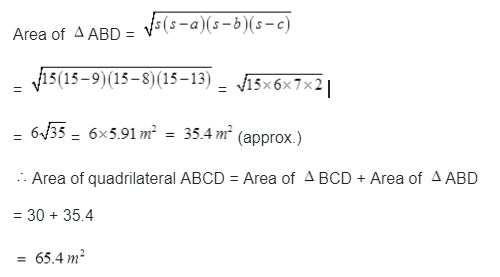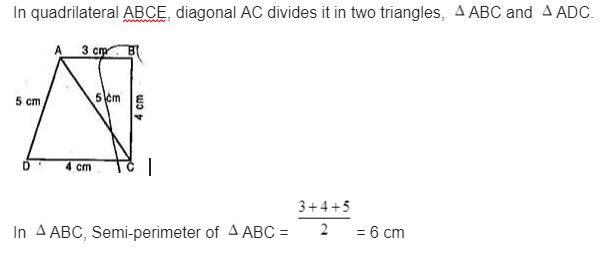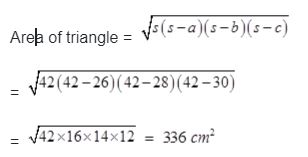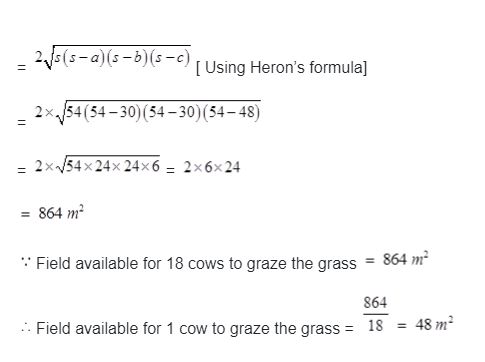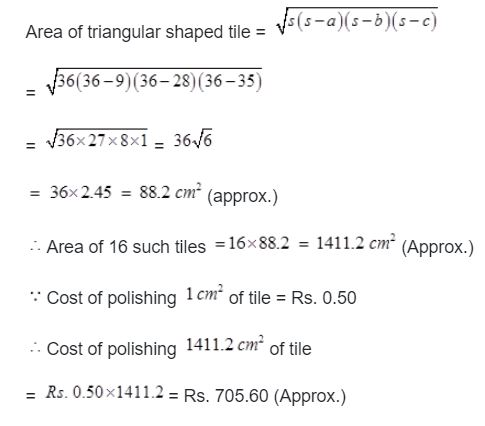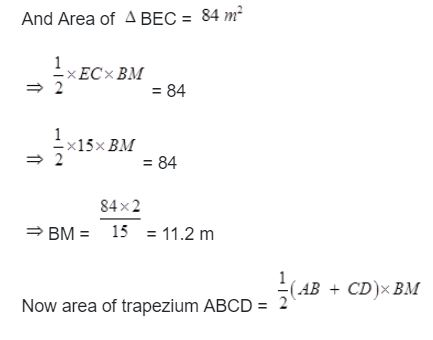NCERT solutions for Class 9 Maths, Chapter 10 "Heron's Formula
These solutions cover important questions and exercises using Heron's Formula, its definition, application, and calculation. Each solution is presented clearly and comprehensively to instill a deep understanding of the main concepts and their applications.
Access Answers to NCERT solutions for Class 9 Maths, Chapter 10 "Heron's Formula
Students can access the NCERT solutions for Class 9 Maths, Chapter 10 "Heron's Formula. Curated by experts according to the CBSE syllabus for 2023–2024, these step-by-step solutions make Maths much easier to understand and learn for the students. These solutions can be used in practice by students to attain skills in solving problems, reinforce important learning objectives, and be well-prepared for tests.
Heron's Formula
Sides of a triangle are in the ratio of 12 : 17 : 25 and its perimeter is 540 cm. Find its area.
Let the sides of the triangle be
a = 12x cm, b = 17x cm, c = 25x cm
Perimeter of the triangle = 540 cm
Now, 12x + 17x + 25x = 540
⇒ 54x = 54 ⇒ x = 10
∴ a = (12 x10)cm = 120cm,
b = (17 x 10) cm = 170 cm
and c = (25 x 10)cm = 250 cm
Now, semi-perimeter, s = 540/2 cm = 270 cm

An isosceles triangle has perimeter 30 cm and each of the equal sides is 12 cm. Find the area of the triangle.
Let the sides of an isosceles triangle be
a = 12cm, b = 12cm,c = x cm
Since, perimeter of the triangle = 30 cm
∴ 12cm + 12cm + x cm = 30 cm
⇒ x = (30 – 24) = 6
Now, semi-perimeter, s = 30/2 cm =15 cm

Thus, the required area of the triangle
= 9√15 cm2
A traffic signal board, indicating ‘SCHOOL AHEAD’, is an equilateral triangle with side a. Find the area of the signal board, using Heron’s formula.If its perimeter is 180 cm, what will be the area of the signal board?
Let each side of the equilateral triangle be a.
Semi-perimeter of the triangle,

The triangular side walls of a flyover have been used for advertisements. The sides of the walls are 122 m, 22 m and 120 m (see figure). The advertisements yield an earning of ₹5000 per m² per year. A company hired one of its walls for 3 months. How much rent did it pay?

Let the sides of the triangular will be
a = 122m, b = 12cm, c = 22m
Semi-perimeter, s = a+b+c/2
(122+120+22/4)m = 264/2 m = 132m
The area of the triangular side wall

Rent for 1 year (i.e. 12 months) per m2 = Rs. 5000
∴ Rent for 3 months per m2 = Rs. 5000 x 3/12
= Rent for 3 months for 1320 m2
= Rs. 5000 x 3/12 x 1320 = Rs. 16,50,000.
There is a slide in a park. One of its side Company hired one of its walls for 3 months.walls has been painted in some colour with a message “KEEP THE PARK GREEN AND CLEAN” (see figure). If the sides of the wall are 15 m, 11 m and 6m, find the area painted in colour.

Let the sides of the wall be
a = 15m, b = 11m, c = 6m
Semi-perimeter,

Thus, the required area painted in colour
= 20√2 m2
Find the area of a triangle two sides of which are 18 cm and 10 cm and the perimeter is 42 cm.
Let the sides of the triangle be a
=18 cm, b = 10 cm and c = x cm
Since, perimeter of the triangle
= 42 cm
∴ 18cm + 10 cm + xcm = 42
x = [42 – (18 + 10)cm = 14cm
Now, semi-permimeter, s = 42/2 cm = 21 cm

Thus, the required area of the triangle
= 21  cm2
cm2
Exercise 12.2
A park, in the shape of a quadrilateral ABCD has C =
C =  AB=9 m, BC = 12 m, CD = 5 m and AD = 8 m. How much area does it occupy?
AB=9 m, BC = 12 m, CD = 5 m and AD = 8 m. How much area does it occupy?
Since BD divides quadrilateral ABCD in two triangles:

(i) Right triangle BCD and (ii) ABD.
ABD.
In right triangle BCD, right angled at C,
therefore, Base = CD = 5 m and Altitude = BC = 12 m
 Area of
Area of  BCD=
BCD= =
=
in  ABD, AB = 9 m, AD = 8 m
ABD, AB = 9 m, AD = 8 m
And BD =  [Using Pythagoras theorem]
[Using Pythagoras theorem]
=>BD =  =
= =
= =13 m
=13 m
Now, Semi=perimeter of  ABD =9+8+13/2= 15m
ABD =9+8+13/2= 15m
Using Heron’s formula,
Find the area of a quadrilateral ABCD in which AB = 3 cm, BC = 4 cm, CD = 4 cm, DA = 5 cm and AC = 5 cm.
Using Heron’s formula,
Radha made a picture of an aeroplane with coloured paper as shown in figure. Find the total area of the paper used.

Area of triangular part I: Here, Semi-perimeter
(s)=5+5+1/2=5.5cm
A triangle and a parallelogram have the same base and the same area. If the sides of the triangle are 26 cm, 29 cm and 30 cm and the parallelogram stands on the base 28 cm, find the height of the parallelogram.
Semi-perimeter of triangle (s)= 26+28+30/2=42cm

Using Heron’s formula,
According to question, Area of parallelogram = Area of triangle
Base x Corresponding height = 336
28*Height= 336
Height = 12 cm
A rhombus shaped field has green grass for 18 cows to graze. If each side of the rhombus is 30 m and its longer diagonal is 48 m, grass of how much area of grass field will each cow be getting?
Here, AB = BC = CD = DA = 30 m and Diagonal AC = 48 m which divides the rhombus ABCD in two congruent triangle.
An umbrella is made by stitching 10 triangular pieces of cloth of two different colours (see figure), each piece measuring 20 cm, 50 cm and 50 cm. How much cloth of each colour is required for the umbrella?

Here, sides of each of 10 triangular pieces of two different colours are 20 cm, 50 cm and 50 cm.

According to question, there are 5 pieces of red colour and 5 pieces of green colour.
A kite is in the shape of a square with a diagonal 32 cm and an isosceles triangle of base 8 cm and sides 6 cm each is to be made of three different shades as shown in figure.

How much paper of each side has been used in it?
Let ABCD is a square of side a cm and diagonals AC = BD = 32 cm
In right triangle ABC, AB2+BC2=AC2[Using Pythagoras theorem]
=> a2+a2=(32)2
=>2a2=32*32
=> a2=32*32/2=512
=> Area of square 512 cm2 [Area of square =side*side]
Diagonal BD divides the square in two equal triangular parts I and II.
Area of shaded part I = Area of shaded part II
=1/2*512=256cm2
Now, semi-perimeter of shaded part III
(s)=6+6+8/2=10cm
Area of shaded part III
A floral design on a floor is made up of 16 tiles which are triangular, the sides of the triangle being 9 cm, 28 cm and 35 cm (see figure). Find the cost of polishing the tiles at the rate of 50 paise per cm2.

Here, Sides of a triangular shaped tile area 9 cm, 28 cm and 35 cm.
Semi-perimeter of tile (s)=9+28+35/2 =36cm
A field is in the shape of a trapezium whose parallel sides are 25 m and 10 m. The non-parallel sides are 14 m and 13 m. Find the area of the field.
Let ABCD be a field in the shape of trapezium and parallel side AB = 10 m & CD = 25 m

And Non-parallel sides AD = 13 m and BC = 14 m
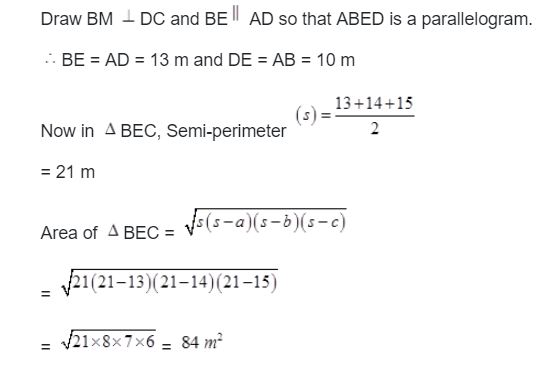
=1/2(10+25)*11.2
=196m2
Admissions Open for 2025-26
Frequently Asked Questions
The NCERT solution for Class 9 Chapter 10: Heron’s Formula is important as it provides a structured approach to learning, ensuring that students develop a strong understanding of foundational concepts early in their academic journey. By mastering these basics, students can build confidence and readiness for tackling more difficult concepts in their further education.
Yes, the NCERT solution for Class 9 Chapter 10: Heron’s Formula is quite useful for students in preparing for their exams. The solutions are simple, clear, and concise allowing students to understand them better. They can solve the practice questions and exercises that allow them to get exam-ready in no time.
You can get all the NCERT solutions for Class 9 Maths Chapter 10 from the official website of the Orchids International School. These solutions are tailored by subject matter experts and are very easy to understand.
Yes, students must practice all the questions provided in the NCERT solution for Class 9 Maths Chapter 10: Heron’s Formula as it will help them gain a comprehensive understanding of the concept, identify their weak areas, and strengthen their preparation.
Students can utilize the NCERT solution for Class 9 Maths Chapter 10 effectively by practicing the solutions regularly. Solve the exercises and practice questions given in the solution.


